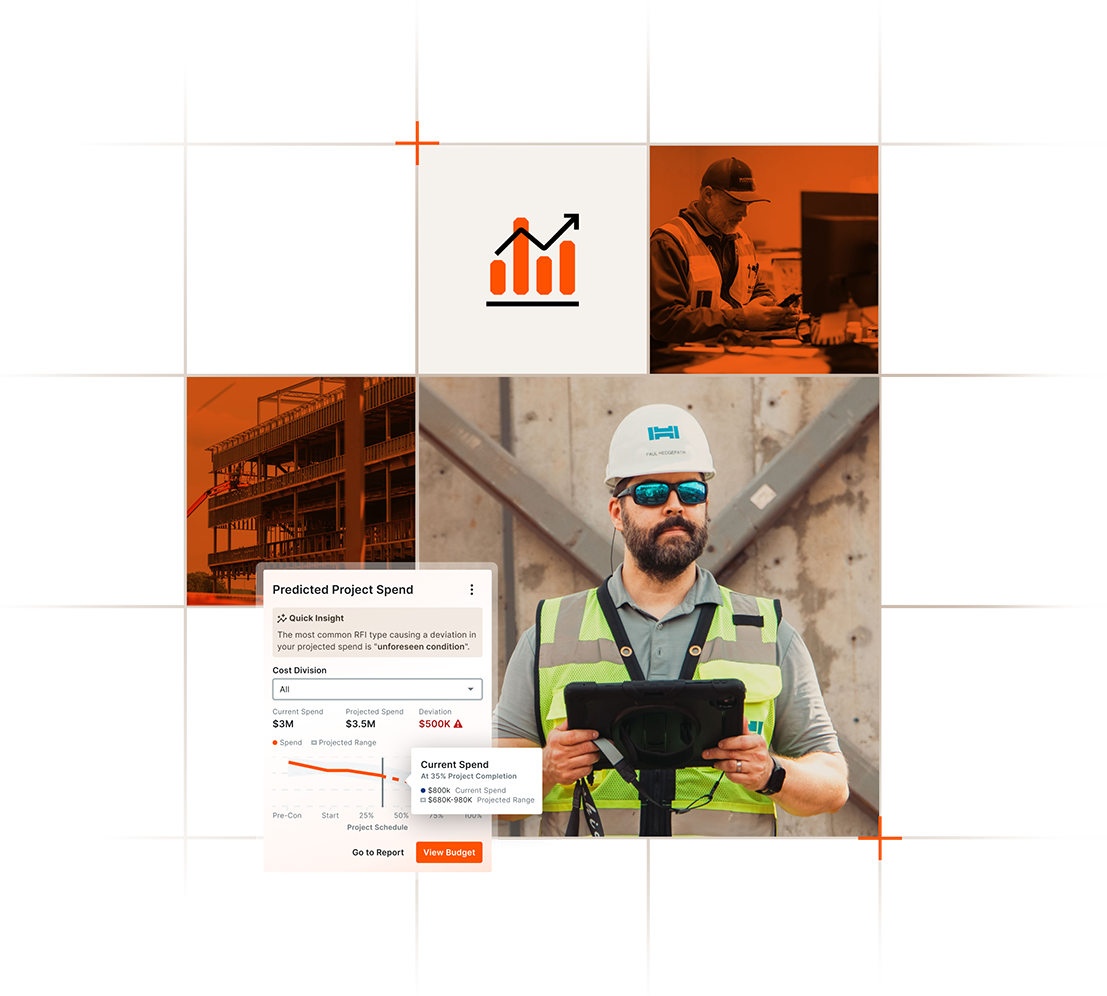— 15 min read
Balance Sheets in Construction: More Than Just Assets & Liabilities


Last Updated Oct 3, 2025

Kelsie Keleher
Senior Strategic Product Consultant, General Contractors
13 articles
Kelsie is a Senior Strategic Product Consultant for general contractors at Procore; working closely with civil and infrastructure clients. Kelsie holds a Masters of Business Administration (MBA) and has close to a decade of experience in construction accounting and finance.

Kristen Frisa
Contributing Writer
111 articles
Kristen Frisa is a contributing writer for Procore. She also contributes to a variety of industry publications as a freelance writer focused on finance and construction technology. Kristen holds a Bachelor of Arts in Philosophy and History from Western University, with a post-graduate certificate in journalism from Sheridan College. She lives in Ontario, Canada.
Last Updated Oct 3, 2025

A balance sheet is a core financial document that helps business owners analyze and make decisions about their costs. A balance sheet lists all assets, liabilities and owners' equity to give a snapshot-in-time view of the company’s net worth.
The balance sheet works alongside the income statement to make up a company's general ledger. The general ledger is then combined with the cash flow statement and work in progress (WIP) schedule to give a comprehensive view of a business' financial health.
This article will discuss what a balance sheet is, how it's used and how to complete one to add to a business' complement of financial documents.
Table of contents
Balance Sheet Basics
Balance sheets can be structured in a number of different ways, but generally, the report is broken into two columns:
- Assets
- Liabilities + Equity
If the financial statement was prepared accurately, the total in both columns will be equal — hence the name “balance sheet.”
Assets
Assets are defined as anything the company owns that has monetary value. This section will include cash bank account balances, fixed assets, equipment, investments, and real estate that the company owns. Assets are generally listed first on a balance sheet.
Most businesses will include two asset categories on their balance sheet:
- Current assets include cash and other assets that they expect to convert to cash within a year. For example, accounts receivable are generally collected within 30-60 days.
- Fixed assets are long-term assets like real estate, heavy equipment, and other investments.
On long-term contracts, retainage may not be receivable within the 12-month period. However, contractors generally include retainage receivable in current assets – with a caveat. According to Fariba Mehdian, a CPA who specializes in construction and real estate, a contractor’s balance sheet will typically include a statement to indicate the special treatment of retainage. For example:
‘Assets and liabilities relating to long-term construction contracts (principally retention) are included in current assets and current liabilities since they will be liquidated in the normal course of contract completion, although this may require more than one year. A one-year time period is used as the basis for classifying all other current assets and liabilities.'
Liabilities
Liabilities include anything the construction business owes, like the total accounts payable and loan balances. Liabilities can be further separated into current liabilities (those with balances due in the next 12 months) and longer-term liabilities like remaining mortgage payments.
For instance, a company that holds a 30-year mortgage would include the next 12 months' worth of payments under current liabilities, and list the following 29 years of payments under long-term liabilities. Breaking up liabilities this way allows companies to run ratios on account balances to get a better picture of a company's financial health.
Equity
Equity represents the company’s net worth, and is a measure of the net income earned by the company over the period that wasn’t distributed to the owners or shareholders. According to the balance sheet formula, Equity = Assets - Liabilities.
Depending on the ownership structure, the final section of the balance sheet may use different terms:
- Sole Proprietorships: Owner’s Equity
- Partnerships: Partners’ Equity
- Corporations: Retained Earnings
Why the Balance Sheet Matters in Construction
The balance sheet is a key document that can be used by business owners and outside investors or creditors to assess the financial health of the company. Before issuing a loan or underwriting a bond, potential creditors – lenders, investors, sureties and clients – will often perform an analysis of a company’s balance sheet, looking for warning signs of poor financial health.
However, a single balance sheet is a snapshot in time – it does not paint a full picture, and can be manipulated with “window dressing.” Creditors, especially sureties and financial institutions, typically want to view multiple years’ worth of financial statements to view longer-term trends – the “story” behind the raw balance sheet numbers.
Business Decisions
A business owner can look at the outcome of the balance sheet as a moment-to-moment view of the company's worth. Liabilities change over time as businesses purchase new equipment or take out a line of credit to do business.
However, if liabilities increase and become greater than the assets, the owner's equity could become negative. Negative owner equity means that if the business were to close that day, the owner could owe a chunk of money to those liabilities because the assets aren't covering them.
Balance sheets are used to compare the business' health month over month or quarter over quarter. For instance, a business could look at the balance sheet at the end of March and then again at the end of June, observing that the account's payable balance increased from $1 million to $3 million over the period. In this case, the liabilities have increased by $2 million in just a few months. The firm can then delve deeper into the details to understand why there are increased liabilities, and then check if there's expected revenue that will cover those costs.
Further, year-over-year trends can identify whether the change is cyclical in nature, which might make it less concerning. In such cases, further action might be unnecessary if the balance sheet reflects a normal pattern for the business.
This kind of information can help a firm decide whether to take on a new project, diversify offerings to even out the earnings a little bit, or buy that new piece of equipment.
Access to Credit
Lenders and bond sureties are both different types of construction creditors. Before lending money or bonding a project, creditors will review a contractor’s balance sheets (in addition to other financial statements and reports) to determine their financial health and project capacity.
The balance sheet can be used to determine whether the company has the capacity and financial strength to take on the upcoming work. Bond agencies will look for a contractor’s access to cash, its net worth and liquidity, and whether it appears it will be able to pay its bills in the coming months. If a contractor ever defaults on a project, the surety wants to know it can recover some of its losses from the contractor’s assets. Like lenders, bond agencies check a firm’s working capital — that is, its assets less its liabilities — to assess how well a company is managing its liquidity.
The surety will also check the debt-to-equity ratio. A high debt-to-equity could indicate a company has just invested in a major project, or it could mean the firm is financially overburdened. Coverage ratios reveal how well a company can meet its upcoming project obligations.
Here's an example of how the information learned from a balance sheet can inform business decisions.
A controller for a construction company is helping to decide whether to begin a new line of business involving concrete paving. In order to start this new venture, the company would have to purchase a machine worth $1.6 million to install curbs quickly and efficiently. The business could look to the balance sheet to assess if there was room to take on an expense like that – are there enough spare assets to cover the new liability?
If the liability is too much, it could throw off the debt ratios, and impact the firm's ability to get other loans that may be necessary for regular operation. The business usually keeps an open line of credit for emergencies. Will the new liability force the firm to close that line of credit, which could start impacting cash flow.
It makes sense for a business to assess these types of calculations because a lender will definitely be doing them, too.
Using balance sheets with equipment ledgers
A balance sheet doesn't usually track individual assets. For example, a company that has ten dump trucks won't track each truck separately using the balance sheet. Payments toward individual assets will often be kept on separate ledgers – either one for each dump truck or one that tracks all dump trucks together.
Construction accountants will reconcile that ledger against the balance sheet, which will help identify any mistakes or omissions.
5 Key Balance Sheet Ratios to Determine Creditworthiness
Before issuing a loan, bond, or other credit instrument, lenders and sureties will review the balance sheet and other financial documents to assess credit risk. While every underwriter uses their own formulas, below are five key numbers that reviewers will often look for in a contractor’s balance sheet.
1. Net Working Capital
Net Working Capital is the difference between a company’s current assets and liabilities. It is one measure of a company’s liquidity, aka their ability to pay bills in the near-term.
A contractor might appear healthily busy with several projects lined up. However, if the firm doesn’t have the cash on hand to get things started, the projects may never get off the ground. One key question for sureties and lenders often ask is: “Does the contractor have sufficient liquidity to support their upcoming work?”
This formula is a simple calculation using information on the balance sheet:
Working Capital = Current Assets – Current Liabilities
Taking this a step further, an underwriter can assess how efficiently a construction company is using their capital to generate revenue. This is called the working capital turnover rate:
Working capital turnover = Net Revenue ÷ Net Working Capital
2. Debt to Equity Ratio
A debt to equity calculation reveals a company’s financial leverage by comparing the amount that the company owes to the owner’s equity. Lenders, sureties, and business owners use it to determine whether the company has enough equity to cover existing debt on top of a new bond or loan. In the event the contractor faces financial losses or bankruptcy, all lenders and sureties have to get in line to recoup their funds. Debt to equity gives lenders an idea of whether owner equity could cover all of the business’ debts in addition to a new bond or loan if worst came to worst.
Debt to equity = liabilities / shareholder equity
3. Aging Accounts Receivable
While many balance sheets will simply show a single line item for Accounts Receivable, in construction, it is common for companies to show different categories of receivables by age.
Lenders and sureties may also ask for an A/R Aging Report, which shows how many days outstanding are each of the receivables listed as assets on a balance sheet. Receivables that are outstanding for more than 90 days — and certainly those that are outstanding for 120 or 150 days — start to look less certain — as if the contractor may be unable to collect them at all. Whether the receivable is attributed to a business that has folded or an owner who disputes the charges, the underwriter may reclassify old accounts as uncollectible, which changes the total of the asset column on the balance sheet.
4. Credit usage
Credit usage is a calculation of the percentage of available credit a business is using at a given time. Construction firms often use revolving credit as part of their business strategies. If a company starts to use a large portion of that credit over a period of time it could pose a credit risk. For example, a contractor with a $1 million line of credit and a balance of $900,000 has a credit usage of 90%, which could raise red flags with sureties and lenders.
To calculate credit usage, add up the balances currently held on loan accounts and divide the total amount of the authorized credit. For the example above, the current balance ($900,000) is divided by the limit ($1 million). Multiply by 100 to get the percentage.
Credit utilization ratio = used credit/available credit x 100
5. Equity to backlog
Equity to backlog shows how much net worth a contractor has to support upcoming projects. A contracting firm that is worth $5 million and has a backlog worth $10 million looks pretty strong. But if that $5 million company had a backlog worth $1 billion, the situation is less tenable. If the firm gets into trouble on one of the projects, the whole company may crumble under the weight.
Backlog doesn’t appear in a balance sheet itself, but is revealed on a Work in Progress (WIP) statement, which is often included with the financial statements.
NOV 6, 2025 at 11:00 AM PST / 2:00 PM EST
Free Webinar: Prove your project management software is profitable
Join Procore and Dodge Data & Analytics for a 2025 Dodge ROI Report deep dive.

The Numbers Tell a Story
The calculations that accountants apply to the numbers on a balance sheet reveal the character of a business. Surety companies will look at the financial statements together to get a fuller picture. They will consider balance sheets over the course of multiple years to find out if the company’s worth is growing or shrinking.
They may also consider the balance sheet alongside the income statement. A small contractor whose net worth is $1 million could look financially stable on the balance sheet, but a look at the financial statements together reveals that they were actually worth -$500k until they were given a government loan worth $1.5 million that was later forgiven. Suddenly, that business looks like it could be a risk to a surety because the business might not be good at building profitably to grow its wealth.
Equally, businesses can use those numbers creatively to change the narrative — to apply window dressing to make the numbers more appealing.
For example, a contracting company takes out a loan to help with expenses over the next year. On a balance sheet, liabilities that come due over the following 12 months are considered current-term liabilities, while anything due after that is a long-term liability. Since surety companies tend to see current or short-term liabilities as a greater risk to the company, the contractor chooses to extend the loan over 13 months and calls it long-term.
Sharp underwriters can identify these types of window dressing and even reclassify line items for a more accurate reflection of a business’ financial health. An underwriter may find outstanding accounts receivables that are six months or a year old and simply remove them from the asset column of a balance sheet if it appears that those receivables may go unpaid.
Balance Sheet Preparation & Review
Depending on the size and price point of a project, a contractor may have to back up the numbers it provides on a balance sheet through an independent review. The bigger a project gets, the more money the surety company is going to back for a contractor. At that level, the lender, the surety, and the owner all want to double and triple-check the information they receive on the strength of a contractor.
Internal
Most accounting software can put a contractor’s finances together for the month and spit out a balance sheet. On a small or simple project, an internally-produced balance sheet may be all that’s required for prequalification. However, it is considered the lowest level of trustworthiness for a financial statement, because a contractor could manipulate it to serve its purposes.
CPA Review
Generally speaking, sureties require some level of assurance from an independent third party to back up the case a contractor makes through its financial statements. A certified professional accountant (CPA) can provide that level of certainty through a formal review. During a review, a CPA will come into the office and checks the books.
CPA Audit
A CPA audit is a full review of everything an accountant can dig up about a contractor and its operations. During an audit, a CPA may call lenders and other surety companies to check the strength and experience of a contractor by pulling samples of contracts for testing and requiring statements of account balances from all fiduciaries.
Learn more: How to Prepare for & Manage a Construction Audit
Best Practices for Construction Balance Sheets
Balance sheets are a tool that construction forms can use in combination with other statements and ledgers to get a picture of their financial health and overall viability. If they're not used properly, they can muddy the waters and make it more difficult to discern what's really going on within a company.
Follow accepted accounting principles.
Balance sheets can provide contractors a lot of insight into their financial health, but only if they're used according to a standard set of rules among everyone within the organization.
Financial statements can be skewed, making it difficult to identify trends or outliers if someone mistakenly expenses something that could be considered an asset, or the other way around. A standard set of rules defining all the terms as the accounting department will use them can help avoid confusion. For example, an asset may be considered a purchase that supports operations, costs more than $3,000, and maintains its value for at least a year after the purchase.
Firms don’t need to invent accounting standards — there is a set of Generally Accepted Accounting Principles (GAAP) issued by the Financial Accounting Standards Board (FASB) that US companies are expected to follow in their financial statements. Using GAAP ensures all construction stakeholders reviewing a set of financial statements understand them in the same way.
Companies outside the US may be expected to use the International Financial Reporting Standards (IFRS), issued by the International Accounting Standards Board (IASB).
Reconcile financial statements often.
Consistent reconciliation allows a business to recognize errors or omissions pretty easily. Things aren't so simple when a company leaves the balance sheet for a year before checking in, and has to check through hundreds of entries to find the mistake.
Comparing the balance sheet to other ledgers may also allow companies to mitigate any fallout that may result from the error. For instance, if the receivables department creates a client invoice worth $1 million, but then realizes the invoice hasn't reflected the required tax amount, they may create a second invoice that includes the tax.
The customer only receives that second invoice, but if the first invoice remains on the books, theAccounts receivable shows an extra $1 million outstanding to collect.
Reconciling the accounts receivable aging report or other listing of outstanding customer invoices will reveal the error.
Making Balanced Financial Decisions
A balance sheet is one critical part of a business’ overall financial picture. Completing the balance sheet according to preset rules, reconciling often with other financial ledgers, and using it to run different accounting ratios can all help guide the direction and decisions a company makes and have a significant bearing on outside stakeholders of the business.
Was this article helpful?
Thank you for your submission.
25%
75%
You voted that this article was . Was this a mistake? If so, change your vote
Scroll less, learn more about construction.
Subscribe to The Blueprint, Procore’s construction newsletter, to get content from industry experts delivered straight to your inbox.
By clicking this button, you agree to our Privacy Notice and Terms of Service.
Thank you!
You’re signed up to receive The Blueprint newsletter from Procore. You can unsubscribe at any time.
Categories:
Written by

Kelsie Keleher
Senior Strategic Product Consultant, General Contractors | Procore
13 articles
Kelsie is a Senior Strategic Product Consultant for general contractors at Procore; working closely with civil and infrastructure clients. Kelsie holds a Masters of Business Administration (MBA) and has close to a decade of experience in construction accounting and finance.
View profile
Kristen Frisa
Contributing Writer | Procore
111 articles
Kristen Frisa is a contributing writer for Procore. She also contributes to a variety of industry publications as a freelance writer focused on finance and construction technology. Kristen holds a Bachelor of Arts in Philosophy and History from Western University, with a post-graduate certificate in journalism from Sheridan College. She lives in Ontario, Canada.
View profileExplore more helpful resources

Construction Accounting Software: Key Features and What To Look For
Commercial contractors manage large and complicated budgets that can have slow payment rates and volatile costs. They also have to accurately allocate job costs based on specific factors such as...

Construction Collaboration: Navigating the Intersection of Project Management and Accounting
Accounting and project teams work together to move the financial aspects of projects through to completion. Data sharing allows for concurrent review to make this possible. Teams need to share...

What are Committed Costs in Construction Accounting?
In construction projects, managing finances can be a challenging task — but understanding committed costs can simplify the process. Committed costs refer to expenses that are guaranteed through formal agreements,...

Understanding Construction Financial Statements
For construction firms, effectively managing financial statements is an important building block for success. These documents play a key role in tracking performance, maintaining financial health and securing future projects....
Free Tools
Calculators
Use our calculators to estimate the cost of construction materials for your next project.
Templates
Find a template to help you with your construction project tasks.
Material Price Tracker
Get the latest U.S. retail prices and view historical trends for common building materials.
Glossary
Explore key terms and phrases used in the industry.
